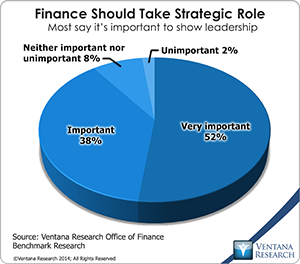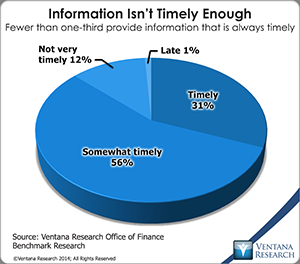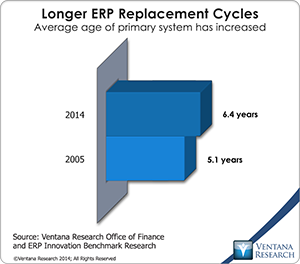SAP Releases Transformative Universal Journal
I recently attended the SAPinsider Financials 2016 conference, a regular event that focuses on the interests and practical needs of people in the finance function of corporations. In several sessions SAP presenters continued to stress its theme of “Simple Finance” as well as making the wry observation that in finance, simple is hard to achieve. To support its theme, the company highlighted ongoing refinement and enrichment of its S/4HANA Finance offering.
The changes taking place in the technologies underlying ERP and financial management systems will have a profound impact on how companies manage their finance and accounting function. Our benchmark research on the Office of Finance shows that for nearly all (90%) companies it is important for their finance organization to play a strategic role. However, it also finds little evidence that this is happening. In order to address the barriers that stymie change in the department, I coined the phrase “continuous accounting” last year. It describes an approach that enables organizations to make the finance function more strategic by using technology to achieve greater efficiency while enabling its people to provide executives and managers more accurate, timely, insightful and action-oriented information about their performance and potential future outcomes to shape their business decisions.
that this is happening. In order to address the barriers that stymie change in the department, I coined the phrase “continuous accounting” last year. It describes an approach that enables organizations to make the finance function more strategic by using technology to achieve greater efficiency while enabling its people to provide executives and managers more accurate, timely, insightful and action-oriented information about their performance and potential future outcomes to shape their business decisions.
The evolutionary pace of technologies that shape the design of ERP and financial management systems has been accelerating over the last couple of years. SAP’s decision to restructure its flagship ERP software is one example of this. It and other vendors are basing ERP systems in the cloud and advancing in in-memory computing; integrating analytics and planning into transaction processing systems; providing mobile access to the systems; building in-context collaboration; and adding streamlined and more intuitive user interface design to enhance productivity and minimize training. There is an unseen and underappreciated link between the design and execution of business processes and the underlying systems on which they are built. In the past it has been largely negative: The limitations of these systems shape how people interact with them and the methods they use. SAP is utilizing these new technologies to eliminate those constraints.
Well-established business processes, such as the periodic accounting close, came about as a result of the restrictions imposed by the paper-based systems on which they were originally based. Processes performed, say, monthly or quarterly developed as the best approach to organizing, coordinating and executing the calculations needed to sum up the debits and credits in journals and ledgers. Those manual systems made a trade-off to balance efficiency and control. Their timing was the result of waiting long enough for a sufficient volume of entries to justify taking the time to perform manual summations, adjustments and consolidations, while not waiting so long as to jeopardize financial control. This didn’t change even when companies initially adopted computer-based systems. These systems’ structure and their batch processing of transactions imposed the same limitations as paper-based record-keeping. Only recently has technology reached a threshold to support transformation of core finance and accounting processes. This transformation will support a more strategic finance and accounting function.
SAP’s Universal Journal is a principal component of the company’s revamped architecture of S/4HANA. It is the single in-memory data store of all transactional and analytical data in the system. This approach to structuring a financial management system is an important evolutionary step because it simplifies the underlying systems and enables significant changes to how processes are performed.
The structure facilitates management of processes and all related data on an end-to-end basis, making it possible to automate repetitive mechanical steps. Universal Journal substantially cuts the volumes of period-end reconciliations (especially relative to SAP’s previous architecture) and almost eliminates the need to check for accuracy because all data is controlled at each step of the process. Consequently, companies can accelerate their accounting close because the automation reduces the amount of period-end work they must perform. Our research shows that companies that automate reconciliations are able to close sooner: 57 percent of those that automate are able to complete their close within six business days, compared to just 27 percent that reconcile manually.
The S/4 HANA Universal Journal supports analytical processes alongside transaction processing, part of a general trend in this direction by ERP vendors that I have noted. This enables companies, for example, to use their own methods for calculating profitability or  other derived performance measures. The data can be automatically derived and stored at the transaction level, enabling instant and consistent analysis. Individuals are able to view up-to-date information in dashboards or any other type of ongoing report from one or multiple perspectives: for example, by business unit or region, product family, customer or time period, or some combination of these. Having up-to-date information addresses a weakness in how finance reports information: Fewer than one-third of companies in our research said that the information they receive is timely. The structure also simplifies the process of enabling users to drill down and around to transaction-level data. They have the ability to immediately transform the information collected at a transaction level into information for reports and dashboards.
other derived performance measures. The data can be automatically derived and stored at the transaction level, enabling instant and consistent analysis. Individuals are able to view up-to-date information in dashboards or any other type of ongoing report from one or multiple perspectives: for example, by business unit or region, product family, customer or time period, or some combination of these. Having up-to-date information addresses a weakness in how finance reports information: Fewer than one-third of companies in our research said that the information they receive is timely. The structure also simplifies the process of enabling users to drill down and around to transaction-level data. They have the ability to immediately transform the information collected at a transaction level into information for reports and dashboards.
There’s an old saying: “Bookkeeping is a matter of facts; accounting is a matter of opinion.” It means that while transactions in a journal or ledger record are precise and objective, accounting requires interpretation and analysis to render a mass of transaction data into a useful summary of a company’s economic performance (an income statement) and condition (a balance sheet). For that reason, Universal Journal offers a subtle but powerful improvement in the structure of a financial management system. It automates the rendition of parallel interpretations of transaction data to suit the multiple sets of requirements that most corporations require. For example, a corporation may have to report locally in a given country using one accounting standard but generate its parent company’s accounts to a securities regulator using a different accounting standard. Some industries – especially financial services – must report to a local regulator using another set of accounting standards. Similarly, generally accepted accounting principles (GAAP) are applied in rendering bookkeeping information into financial statements that principally serve the needs of investors and creditors. But the same facts must be presented differently using management accounting to provide the appropriate analysis and answers to operate the business competently. Distinguishing between statutory and management accounting will be increasingly important as new revenue recognition rules are adopted because those numbers are tied to satisfying customers and in some cases far removed from the booking and cash receipt events that are central to company and finance department operations. Companies most affected by the new rules will need to be able to look at their financial data simultaneously in both a statutory (GAAP) context and a format more useful for the day-to-day management of operations.
Unlike some businesses or software categories where a major product enhancement would spur purchases, it's unlikely that SAP (or any other vendor) will accelerate the replacement of companies’ core ERP or financial management systems. Many CFOs look at replacing their existing software as an opportunity to fix all that’s wrong with their existing setup. However, they usually wait until the need is dire enough to justify the cost and disruption of replacing their existing system. Our research finds that companies are replacing their ERP software less frequently today than a decade ago. We estimate that the replacement cycle is more than a year longer: 6.4 years vs. 5.1 years. Our data also indicates that they are keeping these systems more up-to-date than they did in the past.
where a major product enhancement would spur purchases, it's unlikely that SAP (or any other vendor) will accelerate the replacement of companies’ core ERP or financial management systems. Many CFOs look at replacing their existing software as an opportunity to fix all that’s wrong with their existing setup. However, they usually wait until the need is dire enough to justify the cost and disruption of replacing their existing system. Our research finds that companies are replacing their ERP software less frequently today than a decade ago. We estimate that the replacement cycle is more than a year longer: 6.4 years vs. 5.1 years. Our data also indicates that they are keeping these systems more up-to-date than they did in the past.
SAP is not alone in performing a major overhaul in its ERP and financial management software. Innovations and refinements developed by one vendor are likely to be copied by others. Instant consolidation, integrated analytics and a more productive user experience are likely to be table stakes within five years. However, SAP has the potential to differentiate its offering by substantially reducing implementation costs and accelerating time to value, especially for customers that prefer an on-premises deployment as well as those choosing a multitenant cloud option. Enhancing the configurability of the system – both data structures and business processes and workflows – will help.
Another important area of product differentiation today and in the future is the interface between the user and the software. Screen and process design in ERP systems have been the legacy of a forms-based design paradigm that isn’t necessarily useful as well as technology limitations that no longer exist. Users increasingly don’t want or need to interact with their business applications through desktop or laptop computers, so support for mobile devices has become common. But we are in the infancy of a new syntax of user interactions shaped by technology. Gestures, for example, expand and improve the ways in which users can interact with systems, especially as touch screens become common on all devices. Voice interaction, a potentially powerful advance, is still in its infancy. Notifications and approvals increasingly will be accessible from wearable devices and technology-enhanced watches. Augmented reality is still years away from being a practical reality, but it has the potential to drive major improvements in efficiency and enhance the effectiveness of users’ interactions with the information and analysis held in these systems.
Creating software that fully exploits the capabilities of technology to deliver rich functionality simply will be an ongoing challenge for SAP and other vendors for the next several years. The advances and refinements on display at SAPinsider Financials 2016 represent important steps in realizing the concept of bringing simpler, more powerful software applications to market. Another important challenge facing vendors will be educating executives and managers about the value their companies can realize from adopting a universal journal and other ERP innovations, especially in cataloguing referenceable use cases. In this period of rapidly evolving product capabilities, it’s essential that finance and corporate executives ensure that their organizations keep abreast of how these changes can support the transformation of the finance organization. ERP technology increasingly will allow finance executives to adopt a continuous accounting approach that eliminates much of the repetitive mechanical work that frustrates attempts to make the department more strategic. It can improve the quality of data used in finance processes and substantially reduce the time needed to find and correct errors. The integration of analytics with transaction processing in S4/HANA can give executives and managers more accurate, timely, insightful and action-oriented information about their performance than they may be getting today, thereby increasing the business value of a company’s core ERP system.
Regards,
Robert Kugel
Senior Vice President Research
Authors:

Robert Kugel
Executive Director, Business Research
Robert Kugel leads business software research for Ventana Research, now part of ISG. His team covers technology and applications spanning front- and back-office enterprise functions, and he personally runs the Office of Finance area of expertise. Rob is a CFA charter holder and a published author and thought leader on integrated business planning (IBP).










